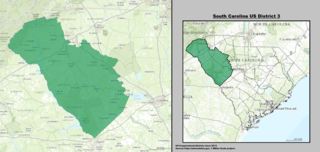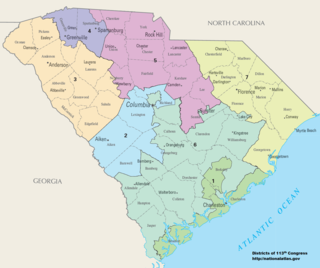
The Upstate is the region in the westernmost part of South Carolina, United States, also known as the Upcountry, which is the historical term. Although loosely defined among locals, the general definition includes the ten counties of the commerce-rich I-85 corridor in the northwest corner of South Carolina. This definition coincides with the Greenville–Spartanburg–Anderson, SC Combined Statistical Area, as first defined by the Office of Management and Budget in 2015, and maintained as of 2017. The region's population was 1,347,112 as of 2016. Situated between Atlanta and Charlotte, the Upstate is the fastest-growing region of South Carolina, and is the geographical center of the Charlanta mega-region. After BMW's initial investment, foreign companies, including others from Germany, have a substantial presence in the Upstate; several large corporations have established regional, national, or continental headquarters in the area. Greenville is the largest city in the region with a population of 67,453 and an urban-area population of 400,492, and it is the base of most commercial activity. Spartanburg and Anderson are next in population.
The Blue Ridge and Atlantic Railroad of the United States purchased the Cornelia-Tallulah Falls section of the North Eastern Rail Road in an attempt to connect Savannah, Georgia to Knoxville, Tennessee. Chartered in 1887, it went bankrupt in about 1892 and in 1898 its properties became part of the newly formed Tallulah Falls Railway.
The Charleston and Western Carolina Railway (C&WC) was formed in 1896 to operate the lines of the former Port Royal and Augusta Railway (PR&A) and the Port Royal and Western Carolina Railway (PR&WC). The PR&A and PR&WC had originally been part of the Central of Georgia Railroad but the South Carolina Legislature had forced the railroad to give up the subsidiary lines. The Atlantic Coast Line Railroad (ACL) took over the C&WC in 1897 but operated it as a subsidiary until 1959 when the ACL fully absorbed it. Much of the original system is still in use by ACL successor CSX Transportation.

The Episcopal Diocese of Upper South Carolina (EDUSC) is a diocese in The Episcopal Church.

The 3rd Congressional District of South Carolina is a congressional district in western South Carolina bordering both Georgia and North Carolina. It includes all of Abbeville, Anderson, Edgefield, Greenwood, Laurens, McCormick, Oconee, Pickens and Saluda counties and portions of Greenville and Newberry counties. The district is mostly rural, but much of the economy revolves around the manufacturing centers of Anderson and Greenwood.

There are currently seven United States congressional districts in South Carolina. There have been as few as four and as many as nine congressional districts in South Carolina. The 9th district and the 8th district were lost after the 1840 Census. Because the state exceeded the nation's average population growth in the 2010 Census, South Carolina regained its 7th district, which had remained unused since the Civil War.

Area code 864 is an area code in the U.S. state of South Carolina that covers Greenville, Spartanburg, Anderson and the other parts of upstate South Carolina. It was split from area code 803 on December 3, 1995.
The Piedmont & Northern Railway was a heavy electric interurban company operating over two disconnected divisions in North and South Carolina. Tracks spanned 128 miles (206 km) total between the two segments, with the northern division running 24 miles (39 km) from Charlotte, to Gastonia, North Carolina, including a three-mile (5 km) spur to Belmont. The southern division main line ran 89 miles (143 km) from Greenwood to Spartanburg, South Carolina, with a 12 mi (19 km) spur to Anderson. Initially the railroad was electrified at 1500 volts DC, however, much of the electrification was abandoned when dieselisation was completed in 1954.
Ninety-Six District is a former judicial district in the U.S. state of South Carolina. It existed as a district from 29 July 1769 to 31 December 1799. The court house and jail for Ninety-Six District were in Ninety Six, South Carolina.

U.S. Route 29 is a north–south United States highway that runs for 109.1 miles (175.6 km) from the Savannah River to Blacksburg, entirely in Upstate South Carolina.
The Savannah Valley Railroad was a railroad company in the U.S. state of Georgia in the early 1880s. It was merged by its lessor, the Port Royal and Augusta Railway, with the Augusta and Knoxville Railroad, Greenwood, Laurens and Spartanburg Railroad and the Greenville and Laurens Railroad into the Port Royal and Western Carolina Railway on October 27, 1886.
The McCormick Subdivision is a railroad line owned and operated by CSX Transportation in the U.S. states of Georgia and South Carolina. The line runs from Augusta, Georgia to Greenwood, South Carolina, for a distance of 62.8 miles (101.1 km). At its south end the line continues north from the Augusta Subdivision and at its north end the line continues north as the Monroe Subdivision.
The Greenville and Columbia Railroad was a 5 ft gauge railroad that served South Carolina in the 19th century.
The Spartanburg, Union and Columbia Railroad was a successor railroad to the Spartanburg and Union Railroad.
The Carolina, Knoxville and Western Railway was a South Carolina railroad that existed in the latter half of the 19th century.









